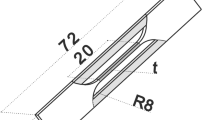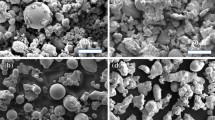Abstract
The laser powder bed fusion (LPBF) process is capable of producing nearly dense 316L stainless steel (SS) parts with a choice of suitable process parameters. These parameters are generally selected from an empirical process mapping involving the input variables of the process (laser power, scan velocity, layer thickness …), independently of the powder characteristics. However, the powder properties (i.e., size, morphology, flowability…) affect the complex physical phenomena involved in the LPBF process. This paper investigates the combined effect of powder properties and process parameters on the LPBF parts density. Firstly, the flowability, relative density, particle size distribution, and absorptance of several powders were measured. Then, these powders were used to produce samples with different process parameters, mainly laser power, scan velocity, and layer thickness. Additionally, computed micro-tomography scanning (µCT) and microscopic analysis methods were used to determine the porosity of the as-built samples and characterize the defects' sizes, types, and locations. The powder size was found to influence the lack of fusion and keyhole boundaries in the process map and consequently affect the operating window. The standard powders with the highest relative density and good flowability were characterized by larger operating windows compared to finer and coarser counterparts. Finally, predictive models were suggested to estimate the porosity of LPBF 316L stainless steel (316L SS) parts by taking into account the powder properties.


















Similar content being viewed by others
Data availability
Not applicable.
Code availability
Not applicable.
References
Fotovvati B, Balasubramanian M, Asadi E (2020) Modeling and optimization approaches of laser-based powder-bed fusion process for Ti-6Al-4V alloy. Coatings 10:(1104). https://doi.org/10.3390/COATINGS10111104
Soni H, Gor M, Singh Rajput G, Sahlot P (2021) A comprehensive review on effect of process parameters and heat treatment on tensile strength of additively manufactured Inconel-625. In: Materials Today: Proceedings. Elsevier, pp 4866–4871
Miranda G, Faria S, Bartolomeu F et al (2016) Predictive models for physical and mechanical properties of 316L stainless steel produced by selective laser melting. Mater Sci Eng A 657:43–56. https://doi.org/10.1016/j.msea.2016.01.028
Hussein A, Hao L, Yan C, Everson R (2013) Finite element simulation of the temperature and stress fields in single layers built without-support in selective laser melting. Mater Des 52:638–647. https://doi.org/10.1016/j.matdes.2013.05.070
Clymer DR, Cagan J, Beuth J (2017) Power-velocity process design charts for powder bed additive manufacturing. J Mech Des Trans ASME 139:100907. https://doi.org/10.1115/1.4037302
Leicht A, Fischer M, Klement U et al (2021) Increasing the Productivity of Laser Powder Bed Fusion for Stainless Steel 316L through Increased Layer Thickness. J Mater Eng Perform 30:575–584. https://doi.org/10.1007/s11665-020-05334-3
Wang S, Liu Y, Shi W et al (2017) Research on high layer thickness fabricated of 316L by selective laser melting. Materials (Basel) 10:1055. https://doi.org/10.3390/ma10091055
Nguyen QB, Luu DN, Nai SML et al (2018) The role of powder layer thickness on the quality of SLM printed parts. Arch Civ Mech Eng 18:948–955. https://doi.org/10.1016/j.acme.2018.01.015
DebRoy T, Wei HL, Zuback JS et al (2018) Additive manufacturing of metallic components – Process, structure and properties. Prog Mater Sci 92:112–224
Abele E, Stoffregen HA, Kniepkamp M et al (2015) Selective laser melting for manufacturing of thin-walled porous elements. J Mater Process Technol 215:114–122. https://doi.org/10.1016/j.jmatprotec.2014.07.017
Liu B, Wildman R, Tuck C et al (2011) Investigaztion the effect of particle size distribution on processing parameters optimisation in selective laser melting process. In: 22nd Annual International Solid Freeform Fabrication Symposium - An Add Manufact Conf SFF. 227–238
Yadroitsev I, Smurov I (2010) Selective laser melting technology: From the single laser melted track stability to 3D parts of complex shape. In: Physics Procedia. Elsevier B.V., pp 551–560
Yadroitsev I, Yadroitsava I, Bertrand P, Smurov I (2012) Factor analysis of selective laser melting process parameters and geometrical characteristics of synthesized single tracks. Rapid Prototyp J 18:201–208. https://doi.org/10.1108/13552541211218117
Scipioni Bertoli U, Wolfer AJ, Matthews MJ et al (2017) On the limitations of Volumetric Energy Density as a design parameter for Selective Laser Melting. Mater Des 113:331–340. https://doi.org/10.1016/j.matdes.2016.10.037
Sutton AT, Kriewall CS, Leu MC, Newkirk JW (2017) Powder characterisation techniques and effects of powder characteristics on part properties in powder-bed fusion processes. Virtual Phys Prototyp 12:3–29
Gürtler FJ, Karg M, Dobler M et al (2014) Influence of powder distribution on process stability in laser beam melting: Analysis of melt pool dynamics by numerical simulations. In: 25th Annual International Solid Freeform Fabrication Symposium. An Add Manufac Conf SFF 1099–1117
Mussatto A, Groarke R, O’Neill A et al (2021) Influences of powder morphology and spreading parameters on the powder bed topography uniformity in powder bed fusion metal additive manufacturing. Addit Manuf 38:101807. https://doi.org/10.1016/j.addma.2020.101807
Guo Q, Zhao C, Escano LI et al (2018) Transient dynamics of powder spattering in laser powder bed fusion additive manufacturing process revealed by in-situ high-speed high-energy x-ray imaging. Acta Mater 151:169–180. https://doi.org/10.1016/j.actamat.2018.03.036
Lane B, Moylan S, Whitenton EP, Ma L (2016) Thermographic measurements of the commercial laser powder bed fusion process at NIST. In: Rap Prototyp J Emerald Group Publishing Ltd., pp 778–787
Donadello S, Motta M, Demir AG, Previtali B (2019) Monitoring of laser metal deposition height by means of coaxial laser triangulation. Opt Lasers Eng 112:136–144. https://doi.org/10.1016/j.optlaseng.2018.09.012
Ahmed Obeidi M, Mussatto A, Groarke R et al (2020) Comprehensive assessment of spatter material generated during selective laser melting of stainless steel. Mater Today Commun 25:101294. https://doi.org/10.1016/j.mtcomm.2020.101294
Khairallah SA, Anderson AT, Rubenchik AM, King WE (2017) Laser powder-bed fusion additive manufacturing: Physics of complex melt flow and formation mechanisms of pores, spatter, and denudation zones. In: Additive Manufacturing Handbook: Product Development for the Defense Industry. CRC Press, pp 613–628
Boley CD, Khairallah SA, Rubenchik AM (2015) Calculation of laser absorption by metal powders in additive manufacturing. Appl Opt 54:2477. https://doi.org/10.1364/ao.54.002477
Gusarov A V, Smurov I (2010) Modeling the interaction of laser radiation with powder bed at selective laser melting. In: Physics Procedia. Elsevier B.V., pp 81–394
Balbaa MA, Ghasemi A, Fereiduni E et al (2021) Role of powder particle size on laser powder bed fusion processability of AlSi10mg alloy. Addit Manuf 37:101630. https://doi.org/10.1016/j.addma.2020.101630
Brika SE, Letenneur M, Dion CA, Brailovski V (2020) Influence of particle morphology and size distribution on the powder flowability and laser powder bed fusion manufacturability of Ti-6Al-4V alloy. Addit Manuf 31:100929. https://doi.org/10.1016/j.addma.2019.100929
Mukherjee T, Wei HL, De A, DebRoy T (2018) Heat and fluid flow in additive manufacturing – Part II: Powder bed fusion of stainless steel, and titanium, nickel and aluminum base alloys. Comput Mater Sci 150:369–380. https://doi.org/10.1016/j.commatsci.2018.04.027
Spierings AB, Levy G (2009) Comparison of density of stainless steel 316L parts produced with Selective Laser Melting using different powder grades. In: 20th Annual International Solid Freeform Fabrication Symposium, SFF, pp 342–353
Schneider CA, Rasband WS, Eliceiri KW (2012) NIH Image to ImageJ: 25 years of image analysis. Nat Methods 9:671–675
Bolte S, Cordelières FP (2006) A guided tour into subcellular colocalization analysis in light microscopy. J Microsc 224:213–232
Ahrens J, Geveci B, Law C (2005) ParaView: An end-user tool for large-data visualization. In: Visualization Handbook. Elsevier, pp 717–731
Gu H, Gong H, Pal D et al (2013) Influences of energy density on porosity and microstructure of selective laser melted 17–4PH stainless steel. In: 24th International SFF Symposium - An Additive Manufacturing Conference, SFF 2013, pp 474–489
Gordon JV, Narra SP, Cunningham RW et al (2020) Defect structure process maps for laser powder bed fusion additive manufacturing. Addit Manuf 36:101552. https://doi.org/10.1016/j.addma.2020.101552
Thijs L, Verhaeghe F, Craeghs T et al (2010) A study of the microstructural evolution during selective laser melting of Ti-6Al-4V. Acta Mater 58:3303–3312. https://doi.org/10.1016/j.actamat.2010.02.004
Kamath C, El-Dasher B, Gallegos GF et al (2014) Density of additively-manufactured, 316L SS parts using laser powder-bed fusion at powers up to 400 W. Int J Adv Manuf Technol 74:65–78. https://doi.org/10.1007/s00170-014-5954-9
Yakout M, Elbestawi MA, Veldhuis SC (2019) Density and mechanical properties in selective laser melting of Invar 36 and stainless steel 316L. J Mater Process Technol 266:397–420. https://doi.org/10.1016/j.jmatprotec.2018.11.006
Rehme O, Emmelmann C, Lasertechnik WG, fur, (2005) Reproducibility for properties of selective laser melting products. AT-Verlag, Stuttgart
Thomas M, Baxter GJ, Todd I (2016) Normalised model-based processing diagrams for additive layer manufacture of engineering alloys. Acta Mater 108:26–35. https://doi.org/10.1016/j.actamat.2016.02.025
Chen X, Wang D, Jiang T, Xiao H (2020) Realtime Control-oriented Modeling and Disturbance Parameterization for Smart and Reliable Powder Bed Fusion Additive Manufacturing. In: Solid Freeform Fabrication 2018: Proceedings of the 29th Annual International Solid Freeform Fabrication Symposium - An Additive Manufacturing Conference SFF, pp 2335–2348
Li Z, Voisin T, McKeown JT et al (2019) Tensile properties, strain rate sensitivity, and activation volume of additively manufactured 316L stainless steels. Int J Plast 120:395–410. https://doi.org/10.1016/j.ijplas.2019.05.009
Meier C, Weissbach R, Weinberg J et al (2019) Critical influences of particle size and adhesion on the powder layer uniformity in metal additive manufacturing. J Mater Process Technol 266:484–501. https://doi.org/10.1016/j.jmatprotec.2018.10.037
Spierings AB, Voegtlin M, Bauer T, Wegener K (2016) Powder flowability characterisation methodology for powder-bed-based metal additive manufacturing. Prog Addit Manuf 1:9–20. https://doi.org/10.1007/s40964-015-0001-4
King WE, Barth HD, Castillo VM et al (2014) Observation of keyhole-mode laser melting in laser powder-bed fusion additive manufacturing. J Mater Process Technol 214:2915–2925. https://doi.org/10.1016/j.jmatprotec.2014.06.005
Gan Z, Kafka OL, Parab N et al (2021) Universal scaling laws of keyhole stability and porosity in 3D printing of metals. Nat Commun 12:1–8. https://doi.org/10.1038/s41467-021-22704-0
Elmer JW (1988) The influence of cooling rate on the microstructure of Stainless steel alloys. Massachusetts Institute Tech
Fotovvati B, Wayne SF, Lewis G, Asadi E (2018) A Review on Melt-Pool Characteristics in Laser Welding of Metals. Adv Mater Sci Eng. https://doi.org/10.1155/2018/4920718
Scipioni Bertoli U, Guss G, Wu S et al (2017) In-situ characterization of laser-powder interaction and cooling rates through high-speed imaging of powder bed fusion additive manufacturing. Mater Des 135:385–396. https://doi.org/10.1016/j.matdes.2017.09.044
Obidigbo C, Tatman EP, Gockel J (2019) Processing parameter and transient effects on melt pool geometry in additive manufacturing of Invar 36. Int J Adv Manuf Technol 104:3139–3146. https://doi.org/10.1007/s00170-019-04229-5
Team J (2020) JASP (Version 0.14.1) [Computer software]
Cherry JA, Davies HM, Mehmood S et al (2015) Investigation into the effect of process parameters on microstructural and physical properties of 316L stainless steel parts by selective laser melting. Int J Adv Manuf Technol 76:869–879. https://doi.org/10.1007/s00170-014-6297-2
Funding
This research was supported by a PhD fellowship from ISAE-SUPAERO and Doctoral School 467 Aeronautics and Astronautics (ED-AA).
Author information
Authors and Affiliations
Contributions
All authors contributed to the study conception and design. The first draft of the manuscript was written by Sabrine Ziri and all authors commented on previous versions of the manuscript. All authors read and approved the final manuscript. Sabrine ZIRI: Conceptualization, Methodology, Validation, Formal analysis, Investigation, Writing-Original Draft, Vizualization. Anis Hor: Writing–Review & Editing, Methodology, Investigation, Supervision. Catherine Mabru: Writing–Review & Editing, Methodology, Formal analysis, Supervision.
Corresponding author
Ethics declarations
Ethics approval
The authors affirm that the results are presented without fabrication and ensure that all the authors mentioned in the manuscript have agreed for authorship, read and approved the manuscript, and gave consent for submission.
Consent to participate
Not applicable.
Consent for publication
Not applicable.
Competing interests
The authors declare no competing interests.
Additional information
Publisher's Note
Springer Nature remains neutral with regard to jurisdictional claims in published maps and institutional affiliations.
Rights and permissions
About this article
Cite this article
Ziri, S., Hor, A. & Mabru, C. Combined effect of powder properties and process parameters on the density of 316L stainless steel obtained by laser powder bed fusion. Int J Adv Manuf Technol 120, 6187–6204 (2022). https://doi.org/10.1007/s00170-022-09160-w
Received:
Accepted:
Published:
Issue Date:
DOI: https://doi.org/10.1007/s00170-022-09160-w




